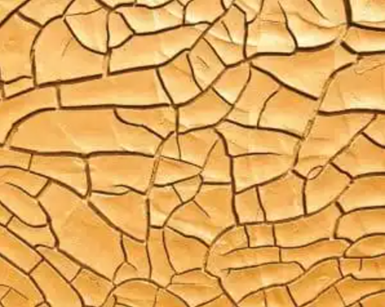How to Avoid Mud Cracking
Julie Holmquist of Cortec Corporation discusses ways to avoid mud cracking defects when applying anticorrosion coatings.

Q: I’m having problems with cracking defects when applying liquid coatings. Do you have any advice for avoiding this kind of defect?
A. No one wants to apply paint or an anticorrosion coating only to come back later and find that it has dried to look like cracked mud. Not only does the texture look bad, but it also leaves behind cracks that go down to the metal surface, making it more susceptible to corrosion. While the problem of mud cracking can only be resolved by removing and reapplying the coating, it is very easy to prevent by following the guidelines below.
Why Does Mud Cracking Happen?
No matter how good a coating is, mud cracking can occur when the coating is applied too thickly. This is because solvents and water evaporate out of the paint at a certain rate as the coating dries. If the coating is too thick, the surface of the coating dries more quickly than the volatiles underneath can evaporate. Once the surface dries, the volatiles are trapped below, and the only way they can escape is by cracking the dry surface layer to get out. While mud cracking can happen with either solvent- or water-based coatings, it is more common in water-based coatings because water evaporates more slowly.
How Can You Prevent Mud Cracking?
The solution for preventing mud cracking is extremely simple: follow the manufacturer’s recommendations for coating thickness. The coating manufacturer already knows how the coating will behave and usually provides both a wet film thickness (WFT) and a dry film thickness (DFT) recommendation on the product data sheet. To avoid mud cracking, the coating applicator simply needs to apply the recommended WFT, measuring coating thickness with a WFT gauge to make sure it is correct.
If only the DFT is listed, the painter can figure out the proper WFT based on the recommended DFT and the percent volume of solids. This percentage tells how much of the coating will remain after the volatiles have evaporated. For example, an approximately 50% volume solids coating such as VpCI-395 will lose about half of its WFT by the time it dries. To get 3 mils (75 µm) DFT, the coating will need to be applied at 6 mils (150 µm) WFT. A coating such as EcoShield VpCI-386 with a 31% volume of solids will lose a little more than two-thirds of WFT by the time it dries, meaning 9.6 mils (240 µm) WFT are needed to achieve 3 mils (75 µm) DFT.
What If You Need a Thicker Coating?
Sometimes, it is necessary to apply a thicker coating than normal. If this is the case, the painter can avoid mud cracking by applying the paint in multiple coats and allowing them to dry in between each application.
Follow Instructions
Often the best way to achieve success is right in front of us. By following WFT recommendations on a coating’s technical data sheet, painters can avoid unnecessary problems and rework caused by mud cracking.
About the Author
Julie Holmquist
Julie Holmquist is a content writer for Cortec Corporation. Visit corteccoatings.com.
Related Content
An Overview of Electroless Nickel Plating
By definition, electroless plating is metal deposition by a controlled chemical reaction.
Read MoreHow to Maximize Nickel Plating Performance
The advantages of boric acid-free nickel plating include allowing manufacturers who utilize nickel plating to keep up the ever-changing regulatory policies and support sustainability efforts.
Read MoreHow to Address Declining Powder Coating Coverage Over Time
Fine particles from reclaim could be to blame for powder coating problems that emerge over time. Avoid problems by keeping hooks clean, maintaining guns and using reclaim powder quickly to avoid accumulation of fines.
Read MoreRead Next
Episode 45: An Interview with Chandler Mancuso, MacDermid Envio Solutions
Chandler Mancuso, technical director with MacDermid Envio discusses updating your wastewater treatment system and implementing materials recycling solutions to increase efficiencies, control costs and reduce environmental impact.
Read MoreEducation Bringing Cleaning to Machining
Debuting new speakers and cleaning technology content during this half-day workshop co-located with IMTS 2024.
Read MoreA ‘Clean’ Agenda Offers Unique Presentations in Chicago
The 2024 Parts Cleaning Conference, co-located with the International Manufacturing Technology Show, includes presentations by several speakers who are new to the conference and topics that have not been covered in past editions of this event.
Read More










.jpg;maxWidth=300;quality=90)










